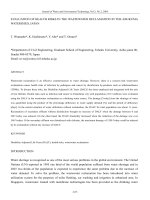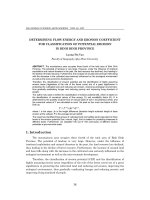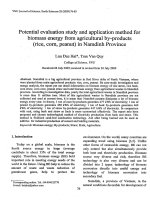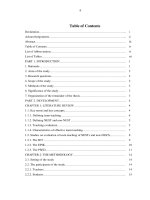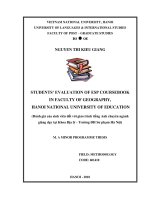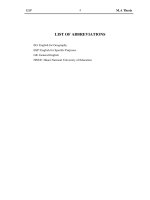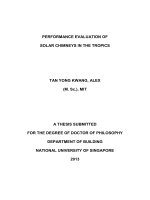- Trang chủ >>
- Cao đẳng - Đại học >>
- Luật
Evaluation of allocation and use of health financing in nam dinh province b luận văn ths hành chính công (chương trình đào tạo thí điểm)
Bạn đang xem bản rút gọn của tài liệu. Xem và tải ngay bản đầy đủ của tài liệu tại đây (4.99 MB, 55 trang )
UPPSALA
UIN1VERSITĨT
UPPSALA UNIVERSITÉT&
IMU UNIVERSITY OF ECONOMICS & BUSINESS
VNU-UEB
1ASTER THESỈS OF MPPM
EViUATION OF ALLOCATION
ANB SE OF HEALTH FINANCING
11 NAM DINH PROVINCE
A u lh o r:
Ninh Thi Hoai Thu
Supervisor:
Dr. H ans Blom kvist
l.ocul Supervisor: I)r. N gu yên Phu Ha
Cíass:
MPPM INTAKE 7
ỉ
f
u
■-
Ị iv:-:..- • V •:
I
i
Hanoi, January - 2015
Acknovvledgements
The thesis has been carried out by thc author NinhThiHoai Thu in the
ìmevvork o f the M aster’s degree program o f Public M anagement -U p p sala
Jẩversity. It is certain that the thesis vvould not be fulfill well without the
ỉnhusiastic help o f the Svvedish and Vietnamese instructors and a number o f
eders and governmental officials o f institutions related to the research field.
I am m uch obliged to Dr. Hans Blomkvist - Uppsala University, Svveden
vb has offered very clearly oriented guides in the process o f my selecting
oúcs and launching research, Dr. Nguyen Phu Ha, leading me in the
esarch process, giving me more knovvledge and helping me resolve
liíìcultiesduring the whole process.
I sincerely thank the lectures who were enthusiastic to impart useful
navledge ot' the public m anagem ent o f the entire course. Thanks for the
uport o f the Universitv o f Economics and Business, o f coordinators and
Ttgram m anagers who have created tầvorable conditions for the course.
I am gratetul to the leaders and experts o f the Department o f Planning
n Finance - Ministry o f Health, thc leaders o f Health Department o f Nam
)ih province for their providing materials, answering in interviews and
ratin g íầvorable conditions, which enables me to perlorm the subịect and
c e ss to data sources.
It is also impossible íor me to tbrget the good feelings and thc support o f
11 c lassmates, friends, colleagues who contributed their ideas, provided
'Ìtirmation to me during my fulfilling the thesis work.
Y o u rs faithfully,
3
Abstract
Tite Evaluation o f the allocation and use o f health lìnancing in Nam Dinh
province.
l£^e: Pinal assignm ent tor Mastcr Program in Public M anagement
Auh >r: NinhThiHoai Thu
Si|e.-visors:
- Dr. Hans Blomkvist - Uppsala University, Sweden
- Dr. Nguyen Phu Ha
Dae when the thesis is presented: 2014 - 12
Ain: The study aimed to evaluate the allocation and use o f íinancial
rsn rc e s o f Nam
Dinh province,
iđentiíy the strengths, weaknesses,
0)p)rlunities and threads o f Nam Dinh province’s health sector in allocation
aid Lse addiíional ĩinancial resources, calculate the expected demand o f
e;p:nses and income possibilities and then to propose solutions to increase
rcvmues to meet spcnding needs and manage hcalth financing in effective
lVehod: Analysis o f docum ents, in-dcpth interviews and SWOT.
RĩSilt & C o nclu sion s: Health sector o i'N a m Dinh province in recent years
hismade rem arkable achievem ents in various íìelds o f healthcare for the
ptO'le, Nam Dinh has íìnished most important output indicators on or ahead
oltie expected plan. Plans to develop health sector closely linked with the 5
yta socio-economic
developm ent
plan
from
2011
to 2015
and the
p»rí)nnance indicators ot' the national health sector. Hovvever, there is no
liik between the plan and the annual budget vvith goals, outcome and output
4
ncicators o f the sector, due to the current Capital expenditure and recurrent
ooenditure is expected to comply with the norms stipulated in Decision
[ 51/2006 / Ọ D -T T g o f the Prime Minister, an annual increase o f about 15%
til íầils to ensure adequate ílnancial resources required to minimum
pcnding demand o f Nam Dinh province’s health. Ít inevitably leads to
'ulget deficits, required to cut down on some spending items, resulting in
01-guaranteed
operating costs o f local health. By necessity o f being
vãlable with solutions to increase revenue sources, the author has applied
V O T analysis for strengths, vveaknesses, opportunities and challenges o f
Jan Dinh province in the m anagem ent o f health íìnancing, assessment o f
lbcation situation, from which calculates the actual spending needs o f the
eilth sector and propose measures to raise revenues tor the health sector
eie.
Based on the calculated demand shorttầll, assess the current íinancial
ĩs)urces and trend analysis o f tìnancial resources can be offset in time to
ían Dinh province, the author makes a num ber o f recom mendations as
)lows:
Ó' expenditures for investment and development
- For the local budget: The Province needs to increase investment
Cipitals from the health hudget at least 20% over the previous year, and
S)end 30% o f the total expenditures for invcstmcnt and development from
tle local budget for health to implement The scheme o f upgrading the
dstrict hospitals and the regional general hospital as deíìned in Decision
N). 47/2008/Ọ D -T T g o f the Prime Minister.
- The province should spend at least 40% o f lottery revenues (expected
líttery source for investment, upgrade o f infrastructure, social welfare,
sich as education, health, culture and sport is about 50 -70 billion
\N D /y ear) for health, especially for investment and upgrade o f the
povincial general hospital, district hospitals and inter-district regional
g-neral hospitals, preventive health centers and etc.
5
- For Central budget: Although the province regulates the adjustment rate
o f the Central budget, because o f the total provincial budget for investment
and development in average level (estimated 800-1000 billion VND/year),
it cannot spend m ore for health. It requires the Central budget to c o n tin u e to
support the province to upgrade provincial general hospital into regional
medical center; upgrade the district health system, especially the district
hospitals and district preventive health centers.
For recurrent expenditu re
- Ensure that the level o f recurrent expenditure on health per capita
prescribed by the Prime Minister, including expenditure increase by 2 0%
because the province has adịustment rate o f t h e budget. Annual increase in
recurrent expenditure over the previous year is
20 %
to reduce shortage in
recurrent expenditure.
- Recurrent expenditure íor provincial hospital beds is around 35-45
million VN D/year, district hospital beds 30-35 million/year, provincial
preventive health centers: 31-35 million VND/staff/year, district preventive
Health centers: 28-32 million VND/staff'/year to ensure regular operation o f
the unit, so that these units can purchase, repair and maintain assets,
equipment and have íìnancial resources for the etTective implementation o f
autonomy, selt-responsibility under Decree No. 43/2006/ND-CP.
For the íinancial m anagem en t
* Enhance the role o f the Department o f Health in Consulting the People's
Committe e to allocation o f local health budget, both regular and investments;
the Department o f Health is allowed to m an age the general budget; the
Department o f ỉỉealth is responsible for:
- Guiding the business units under Department o f Construction to
estimate budget to report to the Department o f Finance, Department o f
Planning and Investment and the People's Com mittee, People's Council for
consideration and decision.
6
- Preparing a plan for allocation o f the budget for health services in local
units, including provincial, district and commune health íầcilities. Consult
the Department o f Finance, Department o f Planning and Investment to the
People's Committee for approval.
- Delivering estimates, adịusted estimates íor the health units in the
province, the preventive medicine centers and district hospitals.
- With regard to the communal level, based on the annual budget
allocation for each district health department, the Department o f Finance
implements supplementation to the district budget to assign estimates o f
recurrent expenditure, expenditures for medical
staffs in communes,
allovvances for medical staffs in villages in the CHS. The allocation for
each commune is decided by the district People's Committee.
* Promote the implementation o f socialization o f iocal health activities such
as: Encourage the đeveloprnent o f non-public health facilities; the province
needs to take land and allocate land without collection o f land use fees for
private hospitals; when planning residential areas and new urban areas and
industrial zones, thc province nccds to regulate land arcas for hospital
construction. Encourage the public medical tầcility to borrovv capitals,
implement joint ventures and associate to install machinery and equipment to
serve medical examination.
* Recommend the Provincial People's Committee to base on the actual
situation in the locality, the People's Council to issue fee levels o f some basic
health services at commune to raise revenues for the operation o f commune
health centers such as hcalth Insurance, health care fund for the poor in order
to improve the quality and performance o f CHS.
Suggestions for íuture research: The limitations o f the thesis wi 11 be
discussed and what can be suggested to study turther in future research
proịects.
7
C on tribu tion o f the thesis: This study providcs directions for changes in the
m anagem ent and use o f íinancial resources o f Nam Dinh province. Ít also
provides useful recom mendations in attracting sources o f revenue to assure
tasks for medical expenses o f Nam Dinh province.
This is a reíerence to the offìcers involved in the reasonable and eíìlcient
planning and allocation o f íỉnancial resources.
8
Table of Contents
ACCRONYMS................................................................................................................... 9
LIST OF T A B L E S ......................................................................................................... 10
1. lntroduction................................................................................................................. 1 1
1.1 General introduction............................................................................................ 11
1.2 Obịectives of the study....................................................................................... 14
1.3 Study questions..................................................................................................... 15
1.4 Study methods...................................................................................................... 15
2. Reference framework................................................................................................ 16
2.1 Strengths............................................................................................................... 17
2.2 Weaknesses........................................................................................................... 17
2.3 Opportunities........................................................................................................ 18
2.4 Threats................................................................................................................... 19
3. Study method.............................................................................................................. 19
4. Data source................................................................................................................... 20
4 .1 Secondary data source.......................................................................................... 20
4.1.1 Data from reports. settlements of revenue and expenditure.................... 20
4.1.2 Data from nevvspapers and internet..............................................................21
4.2 Primary data source...............................................................................................21
5. Researching results..................................................................................................... 22
5.1 Assessment of implementation oí the State Budget Law and its
implementing g u id elin es.....................................................................................................22
5.1.1 Mechanisms and tbrms of budget management........................................ 22
5.1.2 Implementation of expenditure norms/ hudget allocation norms............25
5.1.3 Evaluation ofthe implementation of the Govemment's Decree No. 43 32
5.2 Construction of cost estimates and expenditure needs of the health sector in
Nam D i n h .....................................................................................................................34
5.2.1 Priorities, strategies and activities of local sectors:...................................34
5.2.2 Pinancial demand ot Mcdical Service in Nam Dinh province................. 40
5.3 Financial resources of the medical Service in Nam Dinh................................ 48
6 . Conclusion,
recommendation and contribution of the thesis................................ 50
6.1 Conclusion and recomendation...........................................................................50
6.2 Contribution of the thesis.....................................................................................52
Reíerence...........................................................................................................................53
Appendix...........................................................................................................................55
9
ACCRONYMS
BKHĐT
Ministry o f Planning and Investment
BTC
Ministry o f Pinance
BYT
Ministry o f Health
BNV
Ministry o f Interior
BHYT
Health Insurance
CT M TỌG
National Target Program
UBND
People's Committees
HĐND
People's Council
KCB
Healthcare
KHHGĐ
Pamily planning
NS
Budget
NSNN
State budget
XD CB
Capital construction
SYT
Health department
QĐ
Decision
NĐ
Decree
TTLT
Joint Circular
tr.đ
Million Vietnam dong
gb
Medical bed
bc
Payroll
10
LIST OF T A B L E S
Table 1: SW O T m o d e l ................................................................................................ 15
Table 2: Comparisons betvveen the norms o f Decision 151 and Decision 139
............................................................................................................................................25
l able 3: Budget allocation norms o f Nam Dinh Province..................................27
Table 4: Synthesis o f tìnancial sources in 2011-2013 ....................................... 27
Table 5: Group structures oí'budget expenditure on disease prevention......30
Table
6 : Structures o f expenditure
on health care in 2 0 1 2 ................................. 31
Table 7: Structures o f expenditures on health care in 2 0 1 3 ................................31
Table
8 : Factors
atTecting the needs and priorities o f the Health Sector
D e v e l o p m e n t ...................................................................................................................34
Table 9: Synthesis o f priorities, objectives and strategies..................................37
Table 10: The inain criteria to prepare a tìnaneial p l a n ...................................... 40
Table 11: Expected íìnancial de mand o f t h e medical Service in Nam Dinh. 46
Table 12: Expected tìnancial capacity and shortage o f revenues o f the health
sector in Nam D i n h ....................................................................................................... 47
Table 13: Current status and tendency tor financial c h a n g e s ............................49
1. Introduction
1.1 General introduction
Nam Dinh province located in the Red River Delta with an area o f
1673.6 km2. The west borders on NinhBinh, 1la Nam bordered on the north,
the east is adịacent to Thai Binh province vvhile the South borderson the East
Sea with a coastline o f 72 km2. The province's population is over 1,982,250
people; the province has 9 districts, 1 city, 203 communes and 26 wards.
Currently, the Health Department comprehensively manages province
and district level health units, including 7 provincial hospitals, 7 provincial
health centers,
11
district-level hospitals,
10 district-level
preventives,
branches o f Population
4
10
regional
district-level health centers and
polyclinics,
medical
schools,
and Family planning, totaling up to 41 units.
Districts’ Health Departments are assigned to manage the 232 health centers
o f communes, wards and townships.
Medical network oi' Nam Dinh province is covered with medical
tầcilities from province to district and commune. Including 19 general
hospitals and
8
specialty centers,
10
preventive medicine centers and
1
Healthdepartment’s office, Branch o f Population and Pamily Planning, and 4
regional polyclinics and 232 co mm une health centers; o f which:
- Province level:
+ 8 General hospitals and clinics
+ 1 Sanatorium
+ 7 Provincial SpecialtyCenter
+ 1 Office o f Department, under State management
+ 1 Branch o f Population and Pamily Planning
+ 1 Nam Dinh medical school
- District-level:
+
10 preventive
medicine centers
+ lO g e n e r a l hospitals
+ 4 regional polyclinics
12
- Commune-level:
+ 232 health centers o f communes, wards and
towns
Nam Dinh province is the center o f the Southern region o f the Red River
Delta, which makes it responsible for not only mission o f healthcare for
people within locally but also for healthcare íor those who reside through
surrounding provinces such as Thai Binh, Ninh Binh, Ha Nam. I heretbre, in
Decision No. 153/2006/ỌD-TTg dated 30/6/2006 by the Prime Minister
approving the overall development plan o f Vietnam health system for period
to
2010
and Vision to the year
2020
identiíìed investment in upgrading
general hospitals o f Nam Dinh into the general hospiíal o f Southern region o f
the Red River Delta.
Although Nam Dinh province is a Central province oi' the region with
relatively early developed industry, in recent times its such development has
not been prioritized any more, as a result its agriculturai
and rural
development is still mainlv covered. Per capita income as well as payments
to State budget is relatively low, expenditure needs are great so recei\ing
proportion o f assistance compared with balance o f local budget is over 63%,
vvhich is the highest figure in the Red River Delta provinces. Proportion o f
people living in rural areas account for more than 80%, and with more than
134,000 poor people according to the poverty line, approximately 160,000
children under six years o f age. Therefore, one o f the Central tasks o f the
province is to upgrade the health facilities, especially provincial general
hospitals to meet the needs o f healthcare íor people in the region, districtlevel hospitals, commune health centers to meet the needs o f healthcare tbr
rural people, the poor, children under six years right on the place o f
residence.
With
the health characteristics
mentioned
above,
Nam
Dinh
has
identiíỉed key tasks required budget priorities as follows:
- To strengthen o f developm ent o f hcalth systems to increase the
accessibility o f health services o f the people
13
To enhance accessibility to Health services for the people, to leave
people to be examined and treated right at the íầcilities, it is necessary to
upgrade ỉầcilities, retroíìt equipment, machines to deploy services distributed
to the provinces, districts, communes and disease prevention activities within
local
range.
Accordingly,
in the Corning period the province should
concentrate on: investment in upgrading provincial general hospitals and
some speciality hospitals, including the construction o f new Pediatrics
hospital, investment in upgrading district-level hospitals, preventive healthcare tầcilities.
- To improve the quality o f health services
Ọuality o f health services depends on manyíầctorssuch as proíessional
qualiíications o f medỉcal staíT in the deployment o f medicaltechnology,
liealth services;
on equipmentserved
for diagnosis and treatment;
on
financialabiiity and attitude and sense o f medical staff in serving patients, on
cognitive abilities o f the patients.
Currently, the province has 308 staíì’ with post graduate qualilìcation
(Ph.D, Master, Specialist I, and II), 520 doctors, 48 pharmacists o f tertiary
level.
It is a province with
high-quality mcdical staff, howcver, the
conditions for paticnt services (on inírastructure, equipment) have not met
yet so it could not maximize the dynamism and creativity o f them in
supplying and improving the quality ol'health services.
Some issues to be set up in the Corning period is to: Strengthen medical
staff to ensure the quantity and structure o f health work force in each level as
well as each unit. EtTectively organize, manage and use the work ĩbrce in
supply and improvement o f quality in medical examination and treatment to
the people. ỉmprove qualification o f medical staff along \vith education,
propaganda o f medicalethics, attitude when serving patient for health
workers.
- To ensure the íìnancial resources to care for and protect the health
o f the social policy objects
14
The social policy obịects such as those vvho have contributed to the
revolution are enịoying preferential allowance monthly and objects o f social
protection and other obịects to be bought social Insurance card by the State
has been fully implemented under Decree No. 63/2005 / ND-CP and Joint
Circular No. 21/2005 / TTLT.
- To strengthen the prevention o f diseases, reduce the morbidity and
death by dangerous iníectious diseases
It is necessary to íocus and take care o f mother and child health, food
hygiene and safety, communication and heaỉth education because there are
many diseases getting and passing away related to respiratory, diarrhea ...
From the index and epidemic disease situation mentioned above, during
2009-2011, Nam Dinh province continues to attach much importance to
disease prevention sector and increase spending to sastify disease prevention,
o f which, priority over the care and protection o f mother and children
healths, ensure o f quality o f food hvgiene and saíety, HIV / AIDS
prevention, prevention o f new diseases, infectious diseases...
- To increase efficiency of health íinancing
In the case the budget is limited, thc eíTicicnt use o f resources is a very
important content, theretbrc, it is required to focus on the tasks as
strengthening o f monitoring the use o f tìnancial resources, improvement o f
capacity o f staíT working in tìnance issue, transỉcr o f autonomy o f íinance
í'or the units.
1.2 Objectives o f the study
The study aimed to evaluate the allocation and use o f ílnancialresource
o f Nam Dinh province, identify the strengths, vveaknesses, opportunities and
threats
o f the
healthsector o f Nam
Dinh
in allocation
and
use o f
oíììnancialresources, calculatespendingneeds and expectcapacity o f source o f
revenue
and
then
propose
solutions
to
increase
meetspendingneeds and manage effectivelyhealthfinancing.
revenue
to
15
1.3 Study questions
Some essay quesions to be tbcused to ansvver including:
- Assessment o f the real status o f healthtìnancing m an agem en t in local,
period o f 2011-2013.
- What íầctors related to the allocation and use o f financial resources o f
Nam Dinh province create strengths, weaknesses, opportunities and threats
for health care system o f Nam Dinh province?
- Pormation o f estimate and minimum expenditure needs for Nam Dinh
province and identification o f short fall funding compared to the revenue.
- What should Nam Dinh province do to mobilize workforce and allocate
budget for health reasonablly and effectively?
1.4 Study mcthods
SW O T model was íormed as o f 60th -70th year ago at Stantbrd Research
Institute and was a tool commonly used in the analysis and evaluation o f the
strengths, vveaknesses, opportunities and threats o f a guideline, policy or an
industry to propose necessary measures which should be supplemented or
amcnded. Analysis under SW O T model is the evaluation o f the data
arranged in the íbnn o f a S W O T under a logical order to help readers
understand as well as present and discuss to make decision easier.
SW O T model is applied not only to enterprises but also to State agencies
and non-governmenta! organizations. This method proposed by Albert
1ỉumphrey when studying the Portune 500 companies.
Table 1: SVVOT model
S W O T A NAL YSIS
(Strengths)
(Opportunities)
Inside scene
Outside scene
( Weakness)
(Threats)
Four elements o f SW OT model includes:
Strengths: Kactors, advantages inside can be mobilized and promoted.
16
Weakness: Weaknesses inside (subịective) can he overcame.
Opportunities: Opporlunities caused hy external environment can not
eliminate entirely, but can minimize the impact.
EíTects o f S W O T analysis:
- To help organization knovv how to use their precious resources in the
best way to:
+ Promote strengths to take advantage / opporlunities
+ Promote strengths to minimize diíTiculties / challenges
+ Take advantage / opportunities to overcome vveaknesses
+ Overcome weakness to limit challenges
- Make suggestions about strategies that organization should consider to
apply based on the determination o f the mutual iníluences between íầctors
such as:
+ What programs are thriving?
+ What programs need to stop?
+ What programs need to change, and
+ What programs need to move to indcpendcnt status?
For Health tìnancing issue o f Nam Dinh province, SW OT model is
applied to analyze the various tầctors aíTecting the publie expenditure in
Health
sector o f Nam
Dinh province,
irom that to make difference
alternatives for public expenditure in Health sector o f Nam Dinh province
become more eíTective and reasonable. Besides, other tools can be used for
analysis and evaluation (such as synthetic methods o f data analysis) to obtain
thorough and comprehensive analysis to the above issue.
2. Reíerence framework
Strengths, weaknesses, opportunities, threats (SWOT ) for the allocation
and use o f health tìnancing o f Nam Dinh province.
17
2.1 Strengths
- Health issues related to universal health should be closely cared and
guided by the Party and State leadcrship; clearly reílected in Decree No. 46NQ 1w dated Pebruary 23, 2005 by the Politburo on protection and care o f
peopk 's health in the new situation affirming that the important position o f
the Health sector is the basic íbundation o f health career development.
- Hum an resources serving for Health sector: Medical staíT is o f high
quality (ovcr 400 staff with postgraduate qualifications (PhD, masters,
specialist I, II), 550 doctors, and 55 pharmacists o f university level.
- Investment in Capital construction tends to increase during the period
2009-2012, for facilities,
provincial
and
district
Health sector has inany improvements in the
levels
because
in recent years,
the
province
implemented Decision No. 47/2008 / Q D -T T g and Decision 930 / Q D -TTg
o f the Gove rnm ent for construction, renovation and upgrading o f health
inírastructure for General hospital, levels o f province, district and region;
Tuberculosis, Pediatrics/ obstetrics and gynecology hospitals, Intectious o f
provincial levels via Governm ent bond funds.
2.2 W caknesses
- Although Nam Dinh province located in center o f area and had industry
develop ment early, Ít does not has strong promotion in recent time so the
main stil! is agriculture and rural. Proportion o f people in rural areas makes
up more than 80%, more than ! 34,000 poor people under the poverty
standards,
approximately
160,000
children
under
age
6.
Meanvvhile,
infrastructure equipment as well as the medical station scale o f comm un e are
poor and do not meet standards (although they werc classiíìed National
standards but still lacks o f sotne criteria) and not satisfy health care needs for
people in rural area.
- N u m b e r o f sick-beds, num ber o f health workers is lower than the
average o f the vvhole coưntry. Use capacity o f sick-beds, number o f inpatient
treatments days at the provincial and district levcl o f Nam Dinh higher than
average o f the whole country.
ĐAI H Ọ C Q U Ố C GIA HÀ NÒI
TRUNG TẬM
t h ò n g t in
ỈHƯ V - :
18
- Team o f doctors and nursing sta íĩ (including physicians, nurses,
midvvives) o f the Preventive Medical Center o f provinces and districts,
specialized centers are insufficient.
- Funding tbr training and capacity improvement for health workers at all
levels in the province are small, thus acquisition o f knowledge, treatment
methods or new specialized skills wi 11 be limited. These matters also affect
the quality o f medical services.
- Health insurance also has some limitations such as payment process is
passive, and slow leading to diữìculties for the hospital, the number o f
patients exceeds the higher level leading to deíìcit o f fund.
- Kinancial m anagem ent skills oí' som e health íầcilities do not meet the
requirements. Some units, advising department is weak, confuse in building
o f íìnancial
autonomy
plan,
and
build
internal
spcnding rcgulations,
especially in building o f additional wage payment plan for each individual
building o f block norms for each division, building o f economic and
technical norms tor proíessional expenses.
- There are no ful 1 documents regulating on economic and technical
norms o f sector so many units still meet diHlculty to build the cost norm o f
the test, radiographs... to save expenditure vvhile ensuring quality o f Service.
2.3 Opportunities
- At Decision No. 153/2006 / ỌD-T Tg dated June 30, 2006 by the Prime
Minister approving the development plan o f overall health system in
Vietnam for the period until 2010 and Vision to 2020, identiíìed investmcnt
in upgrading General Hospital o f Nam Dinh province into General hospital
o f South area o f the Red River Delta.
- In the National strategy on protection, care and improvement o f
people's health for the period o f 201 1-2020, Vision to 2030, has stated that
"To ensure adequate funding for reguỉar operations o f commune and ward
heaỉth center and allowance for medical sta ff o f villages, hamlets".
19
2.4 Threats
- During the past time, the province only have a í'ew ODA proịect,
investment Capital from local budget is very limited. Moreover, this Capital
also must íocus on investment in maternity hospital, gencral hospital o f
province to do tasks in the area.
- Disease
structure
changes,
non-communicable
diseases
such
as
hypertension, diabetes... tend to rise, this results in medical costs for these
diseases will increase.
- Medical staff are o f high quality, but the conditions to serve the
patients (on inírastructure, equipment) have not met up yet so they cannot
maximize the dynamism and creativity in supplying and improving quality
o f health services.
- Plan to develop health sector closely links with the social-economic
development plan for 5 years from 201 1 to 2015 and pertbrmance indicators
o f the National health sector. However, it has no cohesion between the plan.
annual budget and goals, outcome and output indicators o f the sector.
- The preventive medicine units use expenditure source from the
National Target Program for their professiona! activities, however this
source is reduced signiiìcantly (up to 50% per year) from 2013 to 2014. The
budget cut o f the National Target Programm means a signiíìcant lack o f
funding tor specialization o f preventive medicine, thus it causes signiĩicantly
affects to the outcome/ objectives o f the sector.
- Health
sector expenditure
complies with
the rules,
norms and
guidelines oí'the Ministry o f Pinance, Ministry o f Planning and Investment
and the Ministry o f Health, however, Social Insurance o f the province still
has
a
number
of
limitation
in
issuing
some
documents
guiding
implementation.
3. Study method
Essay using synthetic - analysis methods, comparison method o f data
combined vvith the interview to analyze S W O T model in the allocation and
use o f health tìnancing in Nam Dinh province.
20
After identifying the study objectives and study questions, thc researcher
conducted to collect a secondary data through a numbcr o f sources as
follows: reports and settlements quarterly - yearly o f health units in the
province, ỉìnal report o f year o f Department o f Health, Department o f
Finance o f Nam Dinh province, tbrmer studies and articles o f individuals as
well as organizations implemented previously...
Aíter synthesis, analysis and comparison o f these data sources, the
researcher gives judgments and assessment o f allocation and use o f health
financing in Nam Dinh province in recent years, then, propose some
solutions to improve the efficiency o f use o f health financing.
Interview wi 11 help researcher reintbrce the identification, assessment o f
the allocation and use situation o f health tìnancing in Nam Dinh province
and the reasonableness o f the proposed solutions.
The researcher conducted to intervievv some officials, leaders at the
General hospital and clinic; preventive medical center o f district, city and
State management unit as Nam Dinh Department o f Health.
Results trom the analysis, synthesis, and comparison o f data will be used
to analyze
SW OT
model
hy
the
researcher to detennine
strengths,
weaknesses, opportunities and threats o f Nam Dinh province in allocation
and use o f health financing. Simultaneously, thereby to give assessments o f
status o f the allocation and use o f íìnancial Health in recent years, identiíy
s o n e difíìculties,challenges, and make recommendations accordingly.
4. Data source
4.1 Secondary data source
4. ỉ. Ị Data fro m reports, settỉements o f revenue and expenditure
Secondary data was collected from reports, settlements o f revenue and
exoenditure quarterly, yearly o f Health care íầcilities from province level to
district and commune levels; from data o f the Department ot' Health,
Department o f Finance; final reports from the projects and programs as vvell
a s t h e published results o f the Conterence, Workshops, surveys and scientitìc
research implemented by organizations and individuals.
21
4.1.2 Data fr o m newspapers and internet
Besides the data collected from reports and settlement quarterly and
annual, researcher also conducted a revievv o f articles related to health
programs
in the recent period. These articles generally reíer to the
co m m un ity
health program s being implemented in hospitals, schools,
c o m m u n e s and districts. Hovvever, synthetic sources o f iníbrmation from
the media, internet were only given iníbrmation on the implementation o f
the primary health care program and had no detailed iníbrmation about the
income and expenditure during program execution. Many articles also
highlighted the ditTiculties and solutions íor local health programs, but they
were only an objective assessment for a speciíìc health programs, rather
than indicating the situation o f the whole health sector in Nam Dinh
province. Hovvever, these are the data sources contributing to give the
actual situation o f the implementation o f health programs.
4.2 Prim ary data source
To increase the accuracy o f the data, as well as clarify the íactors
affecting the allocation and use o f Health iìnancing o f Nam Dinh province,
the researcher conducted interview withrelatcd obịects. Since Nam Dinh
province m anages the enlirc sector íìnancial, so staff working on tìnancial
m anagement is relatively large and experienced management. The Hnancial
management has implemented at the 3 levels: provincial-level (general
hospitals and clinics, branch o f population, medical schools...), district-level
(general hospitals, preventive healthcare centers...), commune-level (health
centers). Therelbre, the author has chosen interviews with a number o f
offícers, employee s and working leaders in all levels: General hospitals and
clinics o f provincial; Preventive health center o f districts; cities, health
centers o f co mm une, wards, towns,... and State management unit as Nam
Dinh Departm ent o f Health to ensure diversity and rcpresentation throughout
the province.
Intervien> contents : The
author
has
direct
interviews
respondents (see the attached list in appendix).
Intervievv questions focus on some questions as follows:
with
íhe
- What is the situation o f public expenditure 1'or hcalth in iacility
(revenue - expenditure sources)?
Hovv is the implementation situation o f health programs at the
tầcility?
- Are there any difficulties in the implementation o f health programs
in locality?
Depend ing on each subject, the researcher will give some additional
questions as follows:
- With annual health financing source, whether is it sufficient to
períorm the duties o f local health or not?
- What are some íầctors affecting to the health budget?
- W hat are some solutions for the allocation and use o f health care
íìnancing in the province?
5. R esearching results
5.1 A ssessm ent o f im plem entation o f the State Budget Law and its
im plem enting guidelines
5. /. / M echanism s and fo r m s o fb u d g et management
a) Recurrent expenditure
- Every year in mid-July, Provincial People's Committee holds a
c o n ĩe r e n c e to m ake e stim a tc s o f State budget revenues and expenditure on
the request o f the Governm ent to hand in to Ministries and submit to the
Government.
- Sectors base on the missions assigned to estimate annual State budget
revenues and
expenditures o f their owns in orđer to submit to the
Department o f Planning and ỉnvestment and Departinent o f Finance tor
revievv and synthesis, to submit to Provincial Peoplc's Committee for
approval and to submit to all Ministries and the Government.
Thus, the Department o f Health makes estimates o f budget revenues and
expenditures íor the whole sectors to report to the Department o f Pinance,
23
Department o f Planning and Investment, to submit Provincial People's
Committee for decision.
Bases for making estimates are: Proposal o f t h e Department o f Health on
expenditure norms to health lầcilities to meet the minimum needs o f sector
expenditure; obịective íầctors affecting estimates next year such as inílation;
new regimes prescribed by the State; increased workload such as beds,
staíììng, increasing number o f health tầcilities, etc.
b) Expenditure on Investm ent
(i) Expenditure on Investment from local budget balance: Every year, the
Department o f Health makes and synthesizes expenditure estimates o f
investment in health projects, reports to the Department o f Planning and
Investment for synthesis and submits to People's Committee in the Province
tbr approval; hcnvever, despite great demand o f estimate establishment o f
Health sector, numbers o f estimate submission are very lovv, only ha lf o f the
estimates o f health sector. Upon submitting estimates, Provincial People's
Committee has assigned the names for each prọịect.
(ii) Targeted expenditure on investment from Central budgct for the
local area.
Targeted
investment
provincial
budget
o f National
is ad d ed
Target
hy the Centre
Programs
to
prevent
from Capital
social
diseases,
dangerous epidemics and HIV/AIDS and upgrade health system o f provinces
and districts.
The Province has not increased annual Capital investments in health from
local budgets o f at least 20% over previous year and spent 30% o f total
investment
in health
under the
implementation
o f Decision
No.225;
thereíore, investment in district hospitals is very limited.
By assessm ent o f budget managem ent in Nam Dinh Province, based
on
interviews with
identiíying
strengths
leaders
()f the
Departm ent
and
weaknesses
of
Nam
m anagem ent o f health financing are listed as follows:
o f Health,
Dinh
essays
Province
in
24
a) StrenỊỊths:
Nam Dinh Department o f Health manages comprehensively health
tìnancing o f provincial
and district units, thus making estimates and
allocation estimates, cost estimates and revievv o f final accounts on nonbusiness expenditure to medical units under its management are very
convenient. uniíìed under íiuidance o f protessional work and manatiement o f
health economics, and all managed in a sector. Punding for recurrent
expenditure o f units is guaranteed by district health sector based on the íĩrstyear estimates.
b) YVeaknesses:
Although Nam Dinh Department o f Health is assigned to manage the
vvhole sector budget, estimates made by Department o f Health achieve
relerence purposes only, reílecting demand on expenditure on health o f the
province because expenditure deinand is huge, but ability to meet budget
estimates is limited.
Discussion on budget is olten based on expenditure
estimates in previous year, expenditure norms are approved hy the People's
Council; increased amount undcr the regimes o f planned year and increased
amount due to increased vvorkload such as staffing, sock-beds, etc. are
calculated on the basis o f local budgets, not calculated on the basis o f
expenditure needs o f units.
In principle, the Department o f Health and Department o f Finance uniíy
data
and
protect
estimates
o f recurrent
expenditure
beíore
People's
Committee o f the Province (including expenditure on commune level). The
Department o f Planning and Investment unify and protect planned targets,
estimates o f expenditure
on
investment development,
expenditure on
National Target Program beíore People's Committee o f the Province for the
Pcople's Council for adoption. But in íầct, proportion o f health budget
increasing over previous year is mainly based on ability o f local budgets for
recurrent expenditure and expenditure on investment and development,
submitted to the People’s Council for adoption and the CommissioiVs People
of the Province for decision.
25
5. ì . 2 Impỉementation ()f expenditure norm s/ budget allocation norms
Budget allocation norms are made in accordance with Decision No.
151/2006/ỌD-TTg dated June 29th 2006 o f the Prime Minister, in which total
expenditure on local health is allocated according to population and
economic - social areas as follows:
Table 2: Com parisons betvveen the norms o f Decision 151 and Decisiơn
139
Unit: dong/person/vear
Region
Allocation
norms in
2007 in
accordance
with
Decision
No. 151
Coeíĩicient
compared
to urban
areas
Allocation
norms in
2003 in
accordance
with
Decision
No. 139
Coeíììcient
compared
to urban
areas
%
between
Norms
No. 151
and
Norms
No. 139
Urban areas
58,680
182
Delta
79,280
1.35
35,400
1.10
224
Mountainous
areas ethnic
groups on
plains,
remote areas
101,100
1.72
44,780
1.39
226
Alpine areas
- islands
140,700
2.40
58,050
1.80
040
32,180
Source: The author synthesis and comparison
- Expenditure norm to health care for the poor: is apart from expenditure
norms o f per Capital ab ove and subịects prescribed by the Government,
expenditure under provisions o f the Prime Minister for each period.
- For administrative expenses o f local health care, more funds are also
allocated to local hospitals in regions/areas: For provinces and cities directly
under Central governm ent, hospitals under local m an agem en t w hich are
guaranteed by local budgets, but operate in areas under provisions o f the
